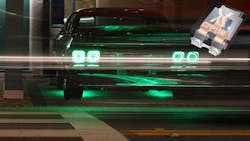Trench Schottky Rectifiers Boost Efficiency for Fast Switching Apps
What you'll learn:
- What attributes give trench Schottky rectifiers the edge in creating efficient designs, such as for LED lighting?
- A key factor for these rectifiers is their clip-bonded FlatPower packaging.
PCIM Europe is one of the world's leading conferences for power electronics—its “PCIM Europe Digital Days 2021” took place online from May 3-7, 2021. Suppliers were available during PCIM to discuss the latest advances in automotive electronics technology, including LED lighting.
Nexperia, for instance, addressed the topic “Trench Schottky Rectifiers: How to increase the efficiency of your switch-mode power converter?,” noting that an ideal rectifier should have a low forward-voltage drop, a high reverse-blocking voltage, zero leakage current, and low parasitic capacitance. However, when it comes to actually realizing those attributes, compromises must be made.
For example, certain metals can be used to minimize the voltage drop across the metal-semiconductor interface, but only at the expense of a higher leakage current. Or if the drift region is made thicker to achieve a higher reverse-blocking voltage, then the advantage of a low voltage drop across the junction may disappear. Traditionally, this has limited the reverse-blocking voltage of Schottky rectifiers to well below 200 V.
The company pointed out that trench Schottky rectifiers meet the challenging demands of efficient and space-saving designs. They combine low forward voltage, reverse current, and very low Qrr to enable optimal efficiency at high switching speeds and high ambient temperatures.
Adding trenches to the Schottky design increases the thermal stability by reducing the leakage currents (IR) and improves switching performance compared to planar counterparts. Trench technology also significantly lowers the charge, or Qrr, stored in the device. On top of that, it trims both the switching losses of the rectifier and the losses induced in the MOSFET in the same commutation cell—a configuration that’s commonly used in asynchronous switch-mode power converters.
Nexperia extended its portfolio of trench Schottky rectifiers with devices rated at up to 100 V and 20 A. The new parts are available in the company’s clip-bonded FlatPower (CFP) packages, which have a much smaller footprint than SMA/SMB/SMC components.
Compared to equivalent planar diodes, the trench devices have a wider safe operating area (SOA). This makes them well-suited for applications that experience higher ambient temperatures.
By delivering that extra safety margin, the PMEGxxxTx devices reduce the risk of thermal runaway compared to parts currently available, according to the company. Thermal runaway starts with heat generated by the leakage current of the rectifier. When not managed, such heat causes the junction temperature to rise faster than the thermal system can remove it. Once the heat rises above a critical temperature, the system becomes thermally unstable and the device could fail. This generally occurs when the reverse power losses generated within the diode exceed the power dissipated by the package.
Jan Fischer, Nexperia’s product manager, said, “Nexperia’s trench Schottky rectifiers combine low forward voltage and very low Qrr to enable best efficiency at high switching speeds as needed in switch-mode power converters. Automotive applications, including LED lighting in particular, will benefit from the wide SOA of our parts.”
Nexperia’s portfolio of trench Schottky rectifiers now includes 32 devices from 40 to 100 V and up to 15 A in volume production. A further 17 parts, including the 20-A types, are sampling. The CFP3/5/15(B) packages for the devices, which feature a solid copper clip, reduce overall thermal resistance and optimize transfer of heat into the ambient environment, allowing for compact PCB designs with significant footprint and height savings. The thermal performance is said to be on par with traditional surface-mount designs such as SMA and SMB.
For designers looking for even more thermal robustness, which may be necessary for applications in very harsh environments—e.g., the high-power-density automotive domain—then the trench Schottky rectifier might reach its thermal limits. In those circumstances, it makes sense to consider the new SiGe rectifiers from Nexperia. Its SiGe rectifiers are all AEC-Q101 compliant and qualified to 175°C.

